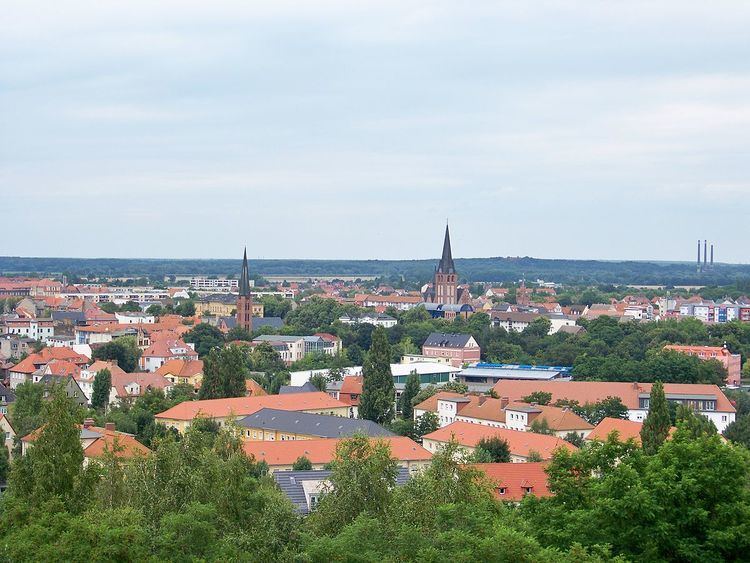Bitterfeld ( [ˈbɪtɐfɛlt]) is a town in the district Anhalt-Bitterfeld, Saxony-Anhalt, Germany. Since 1 July 2007 it has been part of the town Bitterfeld-Wolfen. It is situated approximately 25 km south of Dessau, and 30 km northeast of Halle (Saale).
History and description
Bitterfeld was built by a colony of Flemish immigrants in 1153. It was captured by the landgrave of Meissen in 1476, and belonged thenceforth to Saxony, until it was ceded to Prussia in 1815.
By 1900 Bitterfeld contained an important junction of railways from Leipzig and Halle to Berlin. The population at that time was 11,839; it manufactured drain-pipes, paper-roofing and machinery; and had saw-mills. There were also several coal-mines in the vicinity. Owing to its pleasant situation and accessibility, it had become a favoured residence of business men of Leipzig and Halle.
During the GDR years, it gained notoriety for its chemical industry complex which caused remarkably severe pollution, even by GDR standards. On 24 April 1959 it also was a scene for the Bitterfeld Conference, locally known as the "Bitterfelder Weg". This conference sought to connect the working class with the artists of the day to form a socialist national culture.
In the 21st century Bitterfeld is still an industrial town and it stages the annual United Metal Maniacs metal festival.
The former brown-coal open cast mine of Goitzsche, south-east of Bitterfeld, is a source of numerous fossils in Bitterfeld amber.
Sons and daughters of the town
Johann Ernst Altenburg (1736-1801), trumpeter and organistErwin Ding-Schuler (1912-1945), sturmbannführer and first camp doctor of BuchenwaldPeter Rasym (born 1953), musician, has been playing bass guitar since 1997 with the PuhdysAugust von Parseval (1861-1942), his impact airships developed by him were partly built in Bitterfeld.Walther Rathenau (1867-1922), he brought the chemical industry to Bitterfeld in 1893, thus establishing the rise of the region to the industrial center .Klaus Staeck (born 1938), graphic artist, lawyer and president of the academy of the arts, grew up in Bitterfeld and saw here uprising of 17 June 1953.1851-1863 Gottlieb Meuche1863-1873 Gustav Frischbier1873-1890 Robert Sommer († 1890)1890-1914 Hugo Hermann Adalbert Dippe (1853; † 1916)1915-1927 Ernst Albert Hermann Schmidt1927-1939 Arthur Erdmann Ebermann1939-1945 Erhard Johann Martin Nimz1943-1945 Walter Stieb (Interim)26 April 1945 to 30 August 1945 Gustav Dietrich (deselection by Soviet city commandant) († 1972)September 1945 to 1946 Bernhard Moder1946-1949 Ernst Rettel1949-1950 Karl Salbach1950-1953 Heinz-Rudolf Strauch1953-1959 Wolfgang Stille1959-1971 Else Petrushka1971-1979 Max Dittbrenner1979-1982 Karlheinz Sohr1982-1990 Klaus Barth1990-1994 Edelgard purchase1994-2007 Werner Rauball2007-2009 Horst TischerFrom 2010 Joachim GüllandMaron, Monika: Bitterfelder Bogen. Ein Bericht. Fischer Verlag, Frankfurt am Main 2009, ISBN 978-3-10-048828-2.Lojewsky, Hannelore: Seh’n wir uns nicht in dieser Welt, so seh’n wir uns in Bitterfeld. In: Norbert Kühne: Individuelles Lernen wird an Bedeutung gewinnen. 100 Jahre Hans-Böckler-Berufskolleg Marl/Haltern, Marl 2009, S. 29–30.Klaus Seehafer: Dann sehn wir uns in Bitterfeld. Tagebuch eines Jahres. Mitteldeutscher Verlag, Halle/S. 2009, ISBN 3-89812-664-1.Bitterfeld und das untere Muldetal. Edition no. 1 Böhlau, Cologne; Weimar; Vienna 2004, ISBN 3-412-03803-2 (Werte der deutschen Heimat. Vol. 66).Hackenholz, Dirk: Die elektrochemischen Werke in Bitterfeld 1914–1945. Ein Standort der IG-Farbenindustrie AG. LIT-Verlag, Münster 2004, ISBN 3-8258-7656-X.
